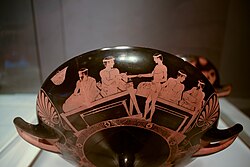

In classical antiquity, writers such as Herodotus,[2] Plato,[3] Xenophon,[4] Athenaeus[5] and many others explored aspects of homosexuality in Greek society. The most widespread and socially significant form of same-sex sexual relations in ancient Greece amongst elite circles was between adult men and pubescent or adolescent boys, known as pederasty (marriages in Ancient Greece between men and women were also age structured, with men in their thirties commonly taking wives in their early teens).[6] Certain city-states allowed it while others were ambiguous or prohibited it.[7] Though sexual relationships between adult men did exist, it is possible at least one member of each of these relationships flouted social conventions by assuming a passive sexual role according to Kenneth Dover, though this has been questioned by recent scholars. It is unclear how such relations between same-sex partners were regarded in the general society, especially for women, but examples do exist as far back as the time of Sappho.[8]
The ancient Greeks did not conceive of sexual orientation as a social identity as modern Western societies have done. Greek society did not distinguish sexual desire or behavior by the gender of the participants, but rather by the role that each participant played in the sex act, that of active penetrator or passive penetrated.[8] Within the traditions of pederasty, active/passive polarization corresponded with dominant and submissive social roles: the active (penetrative) role was associated with masculinity, higher social status, and adulthood, while the passive role was associated with femininity, lower social status, and youth.[8]
- ^ a b Jared Alan Johnson (2015). "The Greek Youthening: Assessing the Iconographic Changes within Courtship during the Late Archaic Period." (Master's thesis). University of Tennessee. Retrieved 5 May 2024.
- ^ Herodotus Histories 1.135 Archived 2022-03-26 at the Wayback Machine
- ^ Plato, Phaedrus 227a Archived 2022-05-15 at the Wayback Machine
- ^ Xenophon, Memorabilia 2.6.28 Archived 2022-04-01 at the Wayback Machine, Symposium 8 Archived 2022-01-04 at the Wayback Machine
- ^ Athenaeus, Deipnosophistae 13:601–606 Archived 2012-07-28 at the Wayback Machine
- ^ Xen. Oec. 7.5 Archived 2022-03-22 at the Wayback Machine
- ^ Cohen, David (1994). Law, Sexuality, and Society: The Enforcement of Morals in Classical Athens. Cambridge University: Cambridge University Press. p. 6. ISBN 9780521466424.
- ^ a b c Oxford Classical Dictionary entry on homosexuality, pp.720–723; entry by David M. Halperin.